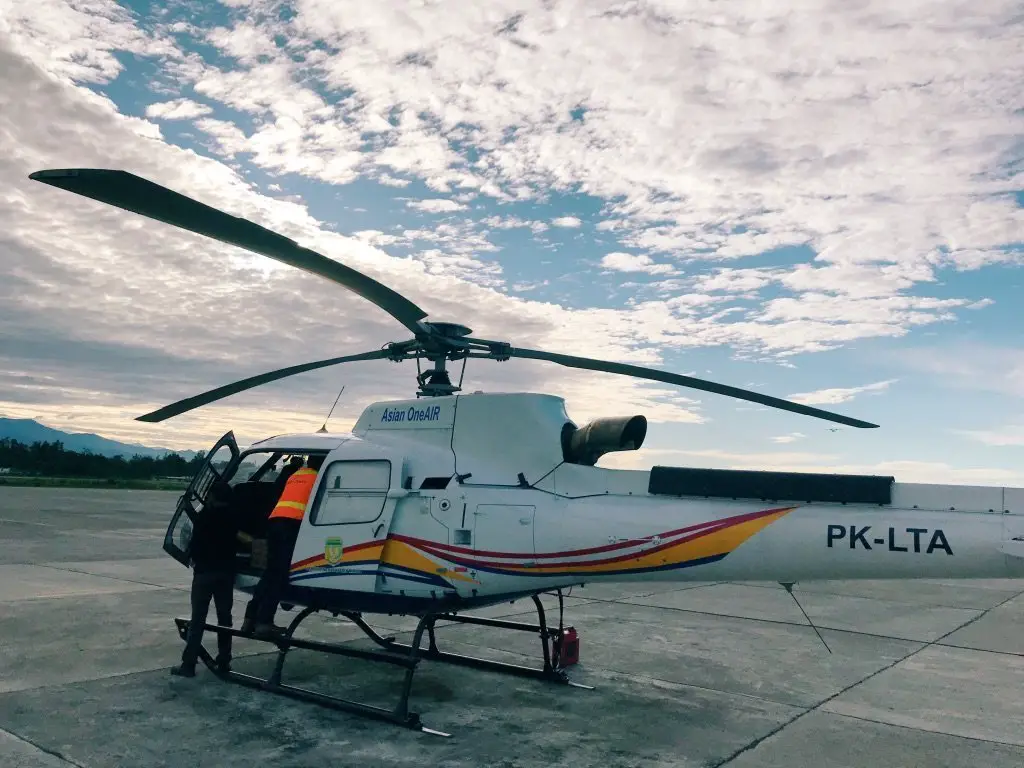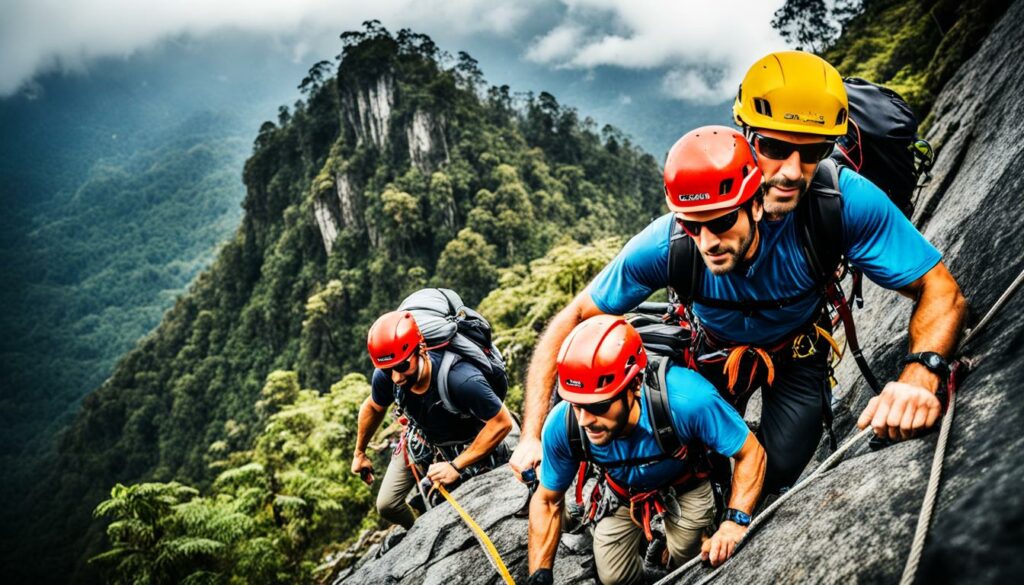“Every mountain top is within reach if you just keep climbing.” – Barry Finlay
Climbing Puncak Jaya, also known as Carstensz Pyramid, is a thrilling expedition that attracts experienced climbers from around the world. Located in the remote and breathtaking Papua region of Indonesia, Puncak Jaya offers a unique challenge and a chance to summit the highest peak in Southeast Asia and Australia. Johnny climbed Puncak Jaya in 2019 and you can read about his summit here in detail.
As you embark on this adventure, choosing the right route becomes crucial for a successful ascent of Mount Carstensz. With multiple routes available, each posing its own set of challenges and rewards, careful consideration is essential to make the most of your Papua climbing expedition.
Key Takeaways:
- Climbing Puncak Jaya, also known as Carstensz Pyramid, is a challenging and rewarding adventure for experienced climbers.
- Choosing the right route is crucial for a successful ascent of Mount Carstensz, the highest peak in Southeast Asia and Australia.
- Puncak Jaya is located in the remote and beautiful Papua region of Indonesia.
- Multiple routes are available, each with its own set of challenges and rewards.
- Proper research and planning are essential before embarking on a Puncak Jaya climbing expedition.
Introduction to Puncak Jaya
Puncak Jaya, also known as Carstensz Pyramid, is an awe-inspiring mountain that holds the title of being the tallest peak in both Indonesia and Australia. It is revered as one of the Seven Summits, which are the highest mountains on each of the seven continents. Located on the remote and captivating island of Papua, Puncak Jaya offers climbers a remarkable and challenging adventure, combined with breathtaking views that make the journey truly unforgettable.
The Highest Mountain in Indonesia and Australia
Puncak Jaya proudly stands as the highest mountain in Indonesia and Australia. With its towering elevation and majestic presence, it commands attention and draws climbers from all over the world. Situated in the heart of the pristine Indonesian landscape, Puncak Jaya showcases the natural beauty of the region as climbers embark on an extraordinary quest to reach its summit.
Conquering the Seven Summits
“Climbing Puncak Jaya is not just about reaching its summit; it is the incredible achievement of conquering one of the Seven Summits. Each step taken towards the pinnacle of Puncak Jaya brings climbers closer to completing this elite mountaineering feat.”
As one of the Seven Summits, Puncak Jaya holds a special place in the hearts of passionate climbers. It offers them the opportunity to experience the diverse landscapes and challenges presented by these monumental peaks. Surrounded by lush greenery and awe-inspiring views, Puncak Jaya beckons adventurers to test their limits and leave their mark on the world of mountaineering.
| Highest Mountain | Location |
|---|---|
| Puncak Jaya | Indonesia |
| Puncak Jaya | Australia |
Puncak Jaya’s Altitude and Technicality
Puncak Jaya, the majestic rock climbing peak, stands proudly at an impressive altitude of 4,884 meters (16,000 feet). As one of the highest peaks in the world, it presents a formidable challenge for climbers seeking an adrenaline-pumping adventure.
The technical nature of the climb sets Puncak Jaya apart from other mountains. It demands advanced rock climbing skills, including proficiency in using ropes and other essential equipment. The steep and rugged terrain adds an extra layer of difficulty, making it suitable only for experienced mountaineers.
“Climbing Puncak Jaya is a test of both physical and mental strength. The sheer technicality of the ascent requires careful planning and precise execution,” says renowned mountaineer Mark Anderson.
The intense preparation and attention to detail required for a successful climb make Puncak Jaya a favorite among rock climbing enthusiasts. The allure of conquering this magnificent peak drives climbers to push their limits and challenge their abilities.
Did You Know?
Puncak Jaya’s technical ascent has earned it a reputation as one of the most sought-after rock climbing destinations in the world.
A Comparison of Altitudes
| Mountain | Altitude (meters) |
|---|---|
| Mount Everest | 8,848 |
| K2 | 8,611 |
| Puncak Jaya | 4,884 |
| Mount McKinley | 6,190 |
Note: Puncak Jaya’s altitude is relative to sea level and may vary slightly based on geological surveys and measurements.
The allure of Puncak Jaya’s altitude and technicality is undeniable. Each step towards its summit is a testament to the determination and perseverance of those who aspire to conquer this awe-inspiring rock climbing peak.
History and Local Culture of Puncak Jaya
Puncak Jaya, also known as Carstensz Pyramid, is not just a majestic mountain, but it also holds a rich history and cultural significance. The fascinating past of this Indonesian peak dates back to the year 1623 when it was first sighted by Dutch explorer Jan Carstenszoon. In honor of his discovery, the mountain was later named Carstensz Pyramid.
However, beyond its connection to exploration, Puncak Jaya is deeply intertwined with the indigenous tribes of the region. These tribes, such as the Dani, Amungme, and Yali, have inhabited the surrounding areas for centuries, preserving their traditional customs and way of life.
Climbers who embark on the journey to summit Puncak Jaya must respect and be mindful of the local culture. The indigenous tribes have a strong spiritual and emotional connection to the mountain, considering it a sacred place. Understanding and appreciating their customs and traditions adds a layer of respect and cultural appreciation to the climbing experience.
“Climbing Puncak Jaya provides not just a physical challenge, but an opportunity to immerse oneself in the local culture and gain a deeper understanding of the region’s history and heritage.” – Local Guide
Indigenous Tribes of Puncak Jaya
The indigenous tribes of Puncak Jaya have a rich cultural tapestry that reflects their deep connection to the natural world. Each tribe has its own unique customs, language, and traditional practices. From the vibrant Dani tribe with their iconic tribal attire to the Yali tribe’s unique architecture, the local culture adds an enriching dimension to the climbing experience.
Visitors to Puncak Jaya are often welcomed by the warmth and hospitality of the indigenous tribes. They generously share their knowledge of the land, provide guidance, and offer insights into their traditional way of life.
Preserving Local Culture
As climbers explore the stunning landscapes of Puncak Jaya, it is crucial to prioritize the preservation of the local culture. This means respecting the customs and traditions of the indigenous tribes, seeking permission before entering their villages, and avoiding any activities that may disrupt or harm their way of life.
Engaging with the local community through responsible tourism can create positive impacts. Supporting local initiatives and purchasing traditional handicrafts directly from the tribes can contribute to their economic well-being and cultural preservation.
How to Get to Puncak Jaya
The journey to Puncak Jaya begins with a flight to the town of Timika in Papua. Located in the heart of Indonesia’s Papua region, Timika serves as the gateway to this majestic mountain. There are several airlines that offer flights to Timika, providing convenient access for climbers from various locations.
Once you arrive in Timika, you have two main transportation options to reach Puncak Jaya. The first option is to hike to the base camp, which offers a challenging and adventurous trek through the lush jungles of Papua. However, it’s important to note that hiking through the jungle is no longer recommended due to safety concerns.
“Hiking through the jungle is no longer recommended due to safety concerns.”
The preferred and safer option for most climbers is to charter a helicopter from Timika to the base camp. Helicopter charters provide a convenient and efficient means of transportation, allowing climbers to reach the base camp quickly and safely. It also offers breathtaking aerial views of the surrounding landscape, adding to the overall experience.

Choosing a helicopter charter allows climbers to focus their energy on the climb itself, rather than spending days hiking to the base camp. It also eliminates the need to navigate through dense jungle terrain, streamlining the entire journey. Johnny also took a helicopter.
Transportation Options Summary:
| Transportation Option | Pros | Cons |
|---|---|---|
| Hiking to Base Camp | Adventurous experience, immersion in nature | Potential safety concerns, longer duration |
| Helicopter Charter | Convenience, time-saving, aerial views | Higher cost, limited capacity |
Ultimately, the choice between hiking to the base camp or chartering a helicopter depends on individual preferences and logistical considerations. While hiking offers a more immersive experience, a helicopter charter provides a safer and more efficient way to reach Puncak Jaya’s base camp.
Best Time to Climb Puncak Jaya
The best time to climb Puncak Jaya, also known as Carstensz Pyramid, is during the dry season, which typically lasts from April to October. The weather in the region is unpredictable, with rainstorms and strong winds common. Climbing during the dry season increases the chances of a successful summit and a safer climb.
During the climbing season, the weather conditions are more favorable, making it easier to traverse the challenging terrain. Rainfall is reduced during the dry season, minimizing the risk of slippery slopes and improving overall climbing conditions.
Although the dry season offers better weather conditions, climbers must still be prepared for sudden changes and take appropriate precautions. It is essential to bring proper rain gear and cold-weather clothing as temperatures can drop significantly at higher altitudes.
It is worth noting that even during the dry season, rainstorms and strong winds can occur, and climbers should always be prepared for unexpected weather conditions. It is important to stay updated on the weather forecast and consult with experienced guides before embarking on the climb.
“Climbing during the dry season increases the chances of a successful summit and a safer climb.”
The image depicts a group of climbers on the summit of Puncak Jaya, showcasing the breathtaking views that can be experienced during a successful climb.
Climbing Puncak Jaya Independently
Climbing Puncak Jaya independently provides a sense of adventure and freedom, but it is not recommended for inexperienced climbers. The challenging terrain and technical skills required make it a risky endeavor without proper preparation. Here are some key factors to consider:
Permits
Obtaining permits from the Indonesian government is necessary to climb Puncak Jaya. The process can be complex and time-consuming, involving paperwork and fees. It is essential to comply with the regulations and ensure all necessary permits are secured before attempting the climb.
Local Guides
Having experienced local guides is crucial for a safe and successful climb. These guides are familiar with the terrain, weather conditions, and have valuable knowledge of the indigenous tribes in the area. They can provide guidance, support, and assistance throughout the expedition, ensuring climbers navigate the challenges effectively.
Climbing Skills
Puncak Jaya requires advanced climbing skills, including rock climbing techniques and the ability to handle difficult terrain. Without proper training and experience, climbers may put themselves at risk and jeopardize their safety. It is recommended to gain expertise in rock climbing before attempting to climb Puncak Jaya independently.
Guided Expeditions
For those who are new to climbing or prefer a safer experience, guided expeditions are highly recommended. These expeditions provide professional guidance, equipment, and logistical support, ensuring climbers have a higher chance of summiting Puncak Jaya successfully. Guided expeditions also offer the opportunity to learn from experienced mountaineers and share the journey with like-minded individuals.
“Climbing independently can be an incredible adventure, but for the challenging terrain of Puncak Jaya, it is best to have the support of experienced guides. They will not only enhance safety but also enrich the overall climbing experience by sharing their knowledge and connecting climbers with the local culture.”
Choosing between climbing independently or joining a guided expedition ultimately depends on individual preferences, experience, and comfort level. While climbing independently may offer a greater sense of freedom, it comes with substantial risks and challenges. Guided expeditions provide a structured and safer approach, offering climbers peace of mind and a higher chance of success.

Cost of Climbing Puncak Jaya
Climbing Puncak Jaya can be an expensive endeavor, with costs ranging from $8,000 to $20,000 USD per person. Johnny paid about 8900$. These expenses include permits, transportation, guides, equipment rental, and accommodation. It is important to budget accordingly and be prepared for the significant investment required to undertake this challenging adventure.
When planning your budget, it is advisable to shop around and do thorough research. Compare prices and services offered by different tour operators to find the best value for your money. Keep in mind that prices may vary depending on factors such as the length of the expedition, the level of support provided, and the quality of equipment supplied.
Remember: While it may be tempting to choose the cheapest option available, it is crucial to prioritize safety, expertise, and quality when selecting a tour operator. Climbing Puncak Jaya is a demanding and technical undertaking, and the experience and professionalism of your guides can significantly impact the success of your climb.
Some tour operators offer package deals that include all necessary services, while others may charge for each individual component separately. It is essential to clarify what is included in the price and ensure that there are no hidden costs.
Tour Operator Price Range Comparison
| Tour Operator | Price Range (USD) |
|---|---|
| Summit Expeditions | $8,000 – $12,000 |
| Puncak Jaya Adventures | $10,000 – $15,000 |
| Carstensz Pyramid Tours | $12,000 – $20,000 |
Note: The prices mentioned above are approximate and subject to change. It is essential to contact tour operators directly for the most up-to-date information and to inquire about any additional fees or services they may offer.
While climbing Puncak Jaya may require a significant financial commitment, the experience of summiting this majestic peak and taking in the breathtaking views is truly priceless. Take the time to plan and save accordingly to make your dream of climbing Puncak Jaya a reality.
Different Routes for Climbing Puncak Jaya
When it comes to climbing Puncak Jaya, there are several routes to choose from, each offering its own unique challenges and rewards. Whether you’re an experienced mountaineer or a thrill-seeking adventurer, finding the right route is essential to a successful and enjoyable climb.
The most common route is known as the “normal route” or Harrer’s Route, named after Heinrich Harrer, who first established it in 1962. This route offers a moderate difficulty climb, making it accessible to climbers with a range of skill levels. It provides a well-defined path and beautiful views along the way, making it a popular choice among climbers.
For those seeking a more challenging adventure, the American Direct route is an option. This route requires advanced rock climbing skills and offers a more technical and demanding ascent. It provides a greater sense of achievement and adrenaline for experienced climbers looking to push their limits.
Another route to consider is the East Ridge. This route offers a combination of technical rock climbing and exposed ridges, providing a thrilling and adventurous climb. It requires a high level of skill, stamina, and mental fortitude, as climbers navigate steep sections and exposed terrain.
Here’s a comparison of the different routes:
| Route | Difficulty | Description |
|---|---|---|
| Harrer’s Route | Moderate | Established path, suitable for a range of skill levels |
| American Direct | Challenging | Technical climb, requires advanced rock climbing skills |
| East Ridge | Advanced | Combination of technical rock climbing and exposed ridges |

Not for the faint hearted – image credit Johnny Ward!
The choice of route depends on your climbing experience, skill level, and personal preferences. It’s important to assess your abilities honestly and choose a route that challenges you without compromising your safety. Additionally, weather conditions play a crucial role in route selection, as certain routes may be more dangerous or inaccessible during certain seasons.
Whichever route you choose, climbing Puncak Jaya is a thrilling and rewarding adventure that will test your physical and mental limits. So, lace up your climbing boots, pack your gear, and get ready to conquer the summit!
Climbing Route Comparison:
Here’s a closer look at the different routes for climbing Puncak Jaya:
- Harrer’s Route – Moderate difficulty, suitable for a range of skill levels
- American Direct – Challenging climb, requires advanced rock climbing skills
- East Ridge – Advanced level, combines technical rock climbing and exposed ridges
Each route offers its own set of challenges and rewards. Consider your skill level, experience, and weather conditions before making your decision. Choose a route that aligns with your abilities and interests to ensure a safe and enjoyable climb.
Typical Itinerary for Climbing Puncak Jaya
When embarking on a journey to conquer Puncak Jaya, a well-planned itinerary is crucial to ensure a safe and successful climb. Here is a typical schedule that climbers can follow:
- Day 1: Arrival in Timika
- Day 2: Transfer to Base Camp
- Days 3-5: Acclimatization at Base Camp
- Day 6: Training and Final Preparation
- Days 7-9: Summit Attempt
- Day 10: Descend to Base Camp and Return to Timika
During the first day, climbers will arrive in Timika, the starting point for their adventure. From there, they will be transferred to the base camp, where they will spend the next few days acclimatizing to the high altitude.
Acclimatization is a crucial step in preparation for the summit attempt. It allows climbers to adjust to the thin air and reduce the risk of altitude sickness. During this time, climbers may undertake short hikes and practice essential mountaineering skills under the guidance of experienced guides.
After completing the acclimatization process, climbers will undergo training and engage in final preparations. This includes reviewing climbing techniques, checking equipment, and discussing the expedition plan with the guides.
The summit attempt typically takes place over three days, allowing for flexibility due to weather conditions. Climbers will make their way towards the summit, facing the challenging terrain and unpredictable weather. The experienced guides will provide guidance and support throughout the ascent.
On the final day, climbers will descend back to base camp before returning to Timika. This provides an opportunity to rest and reflect on the incredible journey and achievements.
| Day | Activity |
|---|---|
| Day 1 | Arrival in Timika |
| Day 2 | Transfer to Base Camp |
| Days 3-5 | Acclimatization at Base Camp |
| Day 6 | Training and Final Preparation |
| Days 7-9 | Summit Attempt |
| Day 10 | Descend to Base Camp and Return to Timika |
It is important to note that the itinerary may vary depending on weather conditions and the fitness levels of the climbers. Flexibility is key to ensure a safe and successful climb. With careful planning and the guidance of experienced guides, climbers can make their way to the summit of Puncak Jaya and experience the breathtaking beauty of this majestic peak.

Not for the faint hearted – image credit Johnny Ward!
Best Time to Climb Carstensz Pyramid
The best time to climb Carstensz Pyramid is during the dry season, which falls between April and October. This period offers more favorable weather conditions for climbers, making the ascent safer and more enjoyable. However, it’s important to note that weather conditions in the region can still be unpredictable even during the dry season. Sudden changes in temperature and precipitation can occur, and climbers should be prepared for both hot and cold conditions.
During the dry season, the temperature at Carstensz Pyramid generally ranges from 5 to 10 degrees Celsius (41 to 50 degrees Fahrenheit) during the day, and it can drop below freezing at night. Climbers should pack appropriate clothing to stay warm in cold temperatures and protect themselves from wind chill.
Additionly, it’s worth noting that afternoon rainstorms are not uncommon in the region, even during the dry season. Therefore, climbers should be prepared for the possibility of rain and make sure to pack appropriate rain gear to stay dry.
“The best view comes after the hardest climb.”
Despite the uncertainties of weather conditions, climbing Carstensz Pyramid during the dry season increases the chances of a successful summit and a safer climb. By being well-prepared and equipped for various weather scenarios, climbers can make the most of their experience and enjoy the breathtaking beauty of this awe-inspiring peak.
| Season | Temperature | Precipitation |
|---|---|---|
| Dry Season (April – October) | 5°C – 10°C (41°F – 50°F) | Variable, occasional rainstorms |
| Rainy Season (November – March) | 12°C – 18°C (54°F – 64°F) | High rainfall |
Difficulty of Climbing Puncak Jaya
Climbing Puncak Jaya is an exhilarating adventure but not without its challenges. The climb is known for its technical difficulty, requiring rock climbing skills and the use of ropes and other equipment. It demands a high level of physical fitness and endurance to navigate the steep and rugged terrain. The success rate of reaching the summit is moderate, but with proper training and preparation, climbers can increase their chances of achieving this remarkable feat.
The Climb Difficulty
The climb difficulty of Puncak Jaya is considered high. It involves technical rock climbing, including traversing vertical and overhanging sections. Climbers must possess advanced climbing techniques and experience to tackle the challenging routes effectively. The mountain presents various obstacles, such as loose rocks, icy patches, and exposure to extreme weather conditions. It requires careful navigation and precise footwork to overcome these hurdles.

Johnny traversing Puncak Jaya.
Technical Skills
Puncak Jaya demands a wide range of technical skills from climbers. Proficiency in rock climbing techniques, such as belaying, rappelling, and ascending, is essential. Experience in handling climbing equipment, including harnesses, helmets, and carabiners, is crucial for safety. Additionally, knowledge of self-rescue techniques and emergency procedures in the event of accidents or equipment failure is vital on this challenging climb.
Physical Fitness
Physical fitness plays a significant role in successfully summiting Puncak Jaya. Climbers must possess exceptional strength, endurance, and agility to endure the demanding ascent. The climb involves long hours of rigorous physical activity, hiking uphill with heavy backpacks, and dealing with high-altitude conditions. Proper training and conditioning, including cardiovascular exercises, strength training, and altitude acclimatization, are necessary to prepare the body for the physical demands of the climb.
Success Rate
The success rate of reaching the summit of Puncak Jaya is moderate. The challenging terrain, unpredictable weather, and technical difficulties contribute to the lower success rate compared to other peaks. However, with careful planning, experienced guides, and optimal weather conditions, climbers can significantly improve their chances of a successful summit bid. It is crucial to prioritize safety and make informed decisions throughout the climb to mitigate risks.
| Challenge | Difficulty |
|---|---|
| Technical Climbing | High |
| Physical Endurance | High |
| Altitude Acclimatization | Moderate |
| Weather Conditions | High |
“Climbing Puncak Jaya is an incredible challenge that pushes climbers to their limits. It requires a combination of technical skills, physical fitness, and mental resilience. But the rewards of standing on the summit and taking in the breathtaking views make it all worthwhile.” – Everest Mountaineering
Safety and Precautions for Climbing Puncak Jaya
When embarking on the challenging adventure of climbing Puncak Jaya, safety should always be a top priority. This section highlights essential safety measures, altitude sickness prevention, considerations for weather conditions, and emergency procedures. It is vital to approach this expedition with caution and be well-prepared for any situation that may arise.
1. Safety Measures
Before beginning the climb, ensure you have taken the necessary safety precautions:
- Obtain comprehensive travel insurance that covers mountaineering activities in remote locations.
- Equip yourself with appropriate climbing gear that is in good condition and suits the technical requirements of the climb.
- Carry a well-stocked first aid kit, including medications to treat common ailments and injuries.
- Communicate your itinerary and emergency contact information with a reliable source to aid in case of an emergency.
- Remain updated on the latest weather forecasts and alerts for the region.
2. Altitude Sickness
Altitude sickness, also known as acute mountain sickness (AMS), can occur at high altitudes and pose health risks. Minimize the chances of altitude sickness by following these guidelines:
- Gradually acclimatize to the high altitude by spending a few days at intermediate camps.
- Maintain hydration by drinking plenty of fluids throughout the climb.
- Avoid alcohol and sedatives, as they can increase the risk of altitude sickness.
- Pay attention to your body and be aware of symptoms such as headache, nausea, dizziness, or fatigue. Descend if symptoms persist or worsen.
3. Weather Conditions
Weather conditions in Puncak Jaya can be unpredictable and extreme. Be prepared for fluctuating temperatures, high winds, rain, and potential storms. Take the following precautions:
- Check the weather forecast before your climb and during the expedition.
- Dress in layers to adapt to changing temperatures – lightweight, moisture-wicking clothing is ideal.
- Carry waterproof gear, including a sturdy rain jacket and pants.
- Protect yourself from the sun with sunscreen, a hat, and UV-blocking sunglasses.
4. Emergency Procedures
Despite thorough preparation, emergencies can still occur. Familiarize yourself with the emergency procedures and take the necessary steps:
“In case of an emergency:
- Notify your climbing partners or guide immediately.
- Administer first aid as necessary and provide support to any injured climbers.
- Follow the instructions of experienced guides or local authorities regarding evacuation or rescue operations.
- Stay calm, maintain a positive mindset, and cooperate with the rescue team.”
Remember, climbing Puncak Jaya is an exciting and challenging adventure, but safety should always be the top priority. By following these safety measures, being aware of altitude sickness symptoms, prepared for weather conditions, and knowing emergency procedures, you can mitigate risks and ensure a safe and successful climb.
Conclusion and Final Thoughts on Climbing Puncak Jaya
Climbing Puncak Jaya is an extraordinary experience that offers both a personal achievement and a thrilling adventure. The breathtaking views from the summit are nothing short of stunning, making it a truly memorable journey for any mountaineer. However, it is important to approach this challenging expedition with proper planning, training, and respect for the mountain and its local culture.
Summiting Puncak Jaya is a testament to one’s climbing experience and perseverance. The journey to the top is filled with physical and mental challenges, but the sense of accomplishment upon reaching the summit is unparalleled. It is a personal achievement that will be treasured for a lifetime.
Not only does climbing Puncak Jaya offer an adrenaline-fueled adventure, but it also allows climbers to immerse themselves in the unique culture and history of the region. It is important to remember to respect and be sensitive to the local customs and traditions while embarking on this once-in-a-lifetime experience.
In conclusion, climbing Puncak Jaya is a rewarding and challenging adventure that offers a stunning experience for those seeking a personal triumph. The breathtaking views, the sense of achievement, and the cultural richness of the region make it a truly exceptional journey. With proper preparation and a deep appreciation for the mountain and its surroundings, climbers can embark on an unforgettable expedition to conquer Puncak Jaya.



